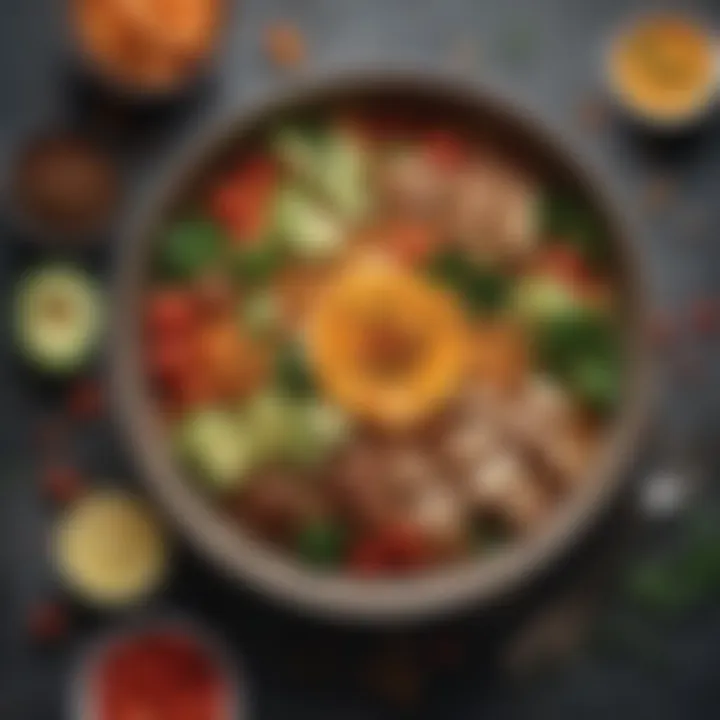Effortless Vegetarian Meal Planning Guide and Shopping List


Intro
Navigating the world of vegetarian cooking can feel like wandering through a beautifully tangled garden. There are countless paths to take, but without a well-mapped plan, one might end up lost among the myriad of choices. For busy individuals and families, taking the plunge into meal planning can often seem like a Herculean task. Yet, properly organizing meals not only enhances your cooking efficiency but also opens the door to a wealth of flavors and nutrition.
This guide seeks to blend creativity with practicality. With a structured vegetarian meal planner, our aim is to empower you to embrace a balance between taste and health while juggling your hectic schedule. Instead of pondering over what to cook each day, you’ll have a week’s worth of meals lined up, along with an organized shopping list that trims down the time spent in the aisles.
In this comprehensive article, we will walk through various sections, highlighting delicious recipes, providing step-by-step cooking techniques, exploring variations and substitutions to suit different tastes, and sharing time-saving tips that make the whole process feel like a breeze. We will also discuss the nutritional benefits of each dish, ensuring you remain informed without the burden of information overload.
Join us as we delve into a culinary adventure—a roadmap designed just for you, where deliciousness meets simplicity!
The Importance of Meal Planning
Meal planning stands as a crucial element in maintaining a balanced and healthy vegetarian diet. In a world where time is often scarce, the act of mapping out meals can greatly enhance not only nutrition but also life quality. It's not just about reversing the stress of last-minute cooking; it’s about fostering a deeper connection with what we eat. This practice instills a sense of order, allowing for culinary creativity while ensuring dietary needs are met with purpose.
Benefits of Meal Planning
Time Efficiency
When it comes down to it, time efficiency is one of the main perks of meal planning. By dedicating a small portion of time each week to design and prepare meals, individuals can save countless hours in the kitchen throughout the busy week. Cook once, enjoy multiple servings — it's a time saver.
A well-structured meal plan makes it easier to shop efficiently. No more wandering the aisles wondering what you need. Instead, a clear list follows directly from planned recipes. Consequently, less time is spent on impulse buys that often derail budget goals. That’s a double win — save time and bolster your finances.
Nutritional Balance
Another significant aspect is nutritional balance. A meticulously planned menu allows vegetarians to ensure they're getting a wide array of nutrients. This proactive approach means meals are thoughtfully composed, preventing the common pitfall of repetitively indulging in the same few dishes.
The unique advantage here is that by spending time planning, you are consciously making choices that promote health. Say goodbye to meals that lack essential protein or fiber. Instead, introduce a variety of ingredients, ensuring every meal contributes positively to your well-being.
Cost-Effectiveness
Let’s not overlook cost-effectiveness. Every savvy shopper knows that unplanned grocery trips can lead to overspending. By planning meals, individuals have a precise idea of what is required for the week’s cuisine.
The standout feature of budget-conscious meal planning is that it allows you to buy in bulk. This not only trims down costs but also reduces the frequency of shopping trips, making it easier to manage your expenses. Avoiding food wastage becomes part of this intelligent approach, as you'll have recipes that utilize the same ingredients multiple times.
Challenges of Meal Planning
Time Constraints
Yet, despite the benefits, meal planning does come with its time constraints. Many people may find it challenging to carve out that initial block of time to sit and adapt meals according to schedules and availability. The paradox here is that while meal planning saves time in the long run, it requires an upfront investment of time that not everyone has.
One unique aspect is the mental load; planning requires juggling various aspects of family preferences, schedules, and dietary restrictions all at once. This can feel daunting, especially if life suddenly changes pace.
Ingredient Accessibility
Ingredient accessibility often introduces another layer of difficulty. Not every grocery store has the same breadth of vegetarian options, and some items might be seasonally available or simply hard to find.
The unique feature here is the pressure it places on creativity. Finding substitutes or alternative ingredients can sometimes yield exciting new dishes, but it can also lead to frustration. Getting accustomed to what’s accessible can make planning feel limiting.
Staying Motivated
Finally, staying motivated is an ongoing struggle. Even the most enthusiastic cooks can hit a wall and plateau in creativity. Over time, what once felt fun can turn routine and dull. This weariness can cause individuals to drift away from their meal planning.
The silver lining is that embracing variation helps to shake things up. Trying new recipes or involving household members can reignite excitement for meal preparation. Old habits may be hard to break, but exploration is key to sustaining interest.
Establishing Your Vegetarian Meal Plans
Creating a solid meal plan is not just about choosing what’s for dinner. It’s about laying down a framework that ensures you eat well, feel satisfied, and maintain a spark of excitement around your meals. Establishing your vegetarian meal plans is essential, particularly for those balancing busy schedules. It allows you to think ahead, avoid last-minute dining dilemmas, and maximize both nutrition and flavor.
Defining Dietary Preferences
Vegan vs. Lacto-Ovo Vegetarian
When considering dietary preferences, one notable distinction is between vegan and lacto-ovo vegetarian lifestyles. Vegans avoid all animal products, while lacto-ovo vegetarians consume dairy and eggs. This difference can significantly shape meal planning strategies. Embracing a vegan diet means relying on a plethora of plant-based proteins like beans, lentils, and quinoa, making it vital to source numerous alternatives to satisfy protein needs. Lacto-ovo vegetarians, having a broader spectrum of food choices, can incorporate dairy products like cheese and yogurt, which might reduce the need for careful protein sourcing. The unique feature of each choice enriches the vegetarian experience; however, both paths share the common advantage of encouraging a diverse palette of fruits and vegetables.
Identifying Allergies
Allergies can complicate meal planning if proper attention isn't given. Identifying allergies early on ensures that all meals remain safe and enjoyable. These might range from common ones like nuts, dairy, or gluten to less frequent food sensitivities. Knowing what to exclude is crucial in crafting meal plans that cater to individual needs. This proactive approach minimizes potential health risks and enhances the overall eating experience. An example of this could be substituting almond milk for cow's milk in recipes, ensuring a delicious alternative without compromising safety. While attending to allergies might seem restrictive, it often nudges us to explore new flavors and ingredients.
Seasonal and Local Produce
Using seasonal and local produce can transform your meal plans from the mundane to the extraordinary. These ingredients are typically fresher, tastier, and often more affordable than their out-of-season counterparts that have been shipped long distances. For instance, tomatoes in summer provide a vibrant burst of flavor, while winter squash shines during colder months. Leveraging the seasons not only supports local farmers but also ensures your diet is varied throughout the year. The distinct characteristic of seasonal produce is its peak flavor, making even the simplest of dishes sing. Moreover, it creates a meaningful connection to the natural rhythms of your local environment.
Balancing Variety and Nutrition
Diverse Protein Sources
A common challenge among vegetarians is balancing protein intake. To overcome it, focusing on diverse protein sources is important. Incorporating legumes, nuts, seeds, and whole grains can ensure adequate protein levels while also offering a good mix of essential amino acids. This unique feature promotes health and supports culinary creativity, as each source brings its own unique taste and texture to the table. For example, pairing chickpeas with quinoa enhances not just flavor but nutritional value.
Incorporating Whole Grains


Whole grains such as brown rice, farro, and barley should be staples in any vegetarian meal planner. They provide essential nutrients and fiber that contribute to overall health. The richness of whole grains lies not just in their health benefits, but also in their ability to add depth and satisfaction to meals. By incorporating them into daily menus, you ensure that each meal is filling and nutritionally balanced, making it a smart choice for those looking to maintain energy levels throughout the day.
Utilizing Seasonal Vegetables
Just like seasonal fruits, vegetables shift with the seasons too. Utilizing seasonal vegetables allows you to take advantage of peak freshness and flavor. Broccoli in the cooler months or asparagus in spring can elevate your cooking experience. This practice not only enhances taste but also tends to be more cost-effective and sustainable. Learning to work with what’s in season fosters creativity as you adapt dishes based on availability, hence making meal times simpler yet more engaging. Embracing variety in your vegetables can help combat the monotony often associated with meal planning.
Creating the Weekly Meal Plan
When we talk about meal planning, creating a weekly plan becomes the backbone of a successful vegetarian lifestyle. Think of it as laying out a game plan before every match. Having a structured meal plan not only alleviates the daily scramble of deciding what to eat but also ensures you’re consistently meeting your nutritional needs.
The benefits of a well-thought-out meal plan are numerous. First off, it helps in reducing food waste. By knowing what meals you’ll prepare, you can buy just the right amount of ingredients. This step alone can save you money and provide a sense of accomplishment. But it goes beyond just the wallet; it cultivates a habit of mindful eating. Plus, having meals planned helps with time management. Rather than wandering aimlessly through your kitchen, you can concentrate on enjoying the cooking process.
Sample Meal Plan Template
Breakfast Options
Breakfast is often dubbed the most important meal of the day—and rightly so. It’s what fuels you up for the day ahead. Vegetarian breakfast options can be as filling as they are diverse. From smoothies packed with spinach and chia seeds to savory oat bowls topped with a sunny-side-up egg, the choices are plenty.
Key characteristics of breakfast options include protein and fiber, which provide the energy needed for a busy day. Popular choices like Greek yogurt with granola and seasonal fruits not only taste delightful but also offer substantial health benefits. Unique features of breakfast options, particularly vegetarian ones, include versatility. You can easily swap ingredients based on what you have lying around, making it a practical choice for your meal plan.
Lunch Selections
Lunch can be a bit tricky for some, especially when balancing flavor with nutrition. A well-structured lunch can serve as a bridge to keep your energy up until dinner. Think about chickpea salads bursting with flavors, whole-grain wraps with hummus, or vibrant grain bowls with quinoa and roasted vegetables.
What stands out in lunch selections is their convenience: they can generally be made in larger batches to save time. Furthermore, a unique feature, like adding a protein-rich ingredient such as lentils or beans, boosts satiety. However, some lunches can be less appealing if prepped too far in advance, losing that fresh crunch or vibrant flavor.
Dinner Ideas
Dinner is often the centerpiece of the day, especially in family settings. It’s when you unwind and connect. Vegetarian dinner ideas can range from hearty stir-fries with tofu and broccolini to warming soups filled with lentils and spices. What makes dinner choices so appealing is they can be both comfort food and health-conscious.
The unique feature of hearty soups is their ability to meld flavors together, creating something that feels special without tons of effort. Still, dinner can sometimes turn into a conundrum when dealing with time constraints—works nights or late meetings can make quick prep essential.
Snacks and Desserts
Snacks and desserts can often be the unsung heroes of meal planning. They offer an opportunity to indulge while still being part of a healthy diet. Think of energy balls made with dates and nuts, or sliced apple with almond butter.
A key characteristic of great snacks is their portability, making them superb for on-the-go solutions. Besides, planning out snacks can help avoid those impulse buys that are hardly veggie-friendly. The unique aspect of desserts, like a chia seed pudding, is that they can double as both a treat and a nutrient-dense food item. On the downside, if not carefully chosen, they can become sugary traps, leading to cravings.
Tips for Flexibility
Substituting Ingredients
Flexibility in meal planning is crucial, especially for busy lifestyles. Substituting ingredients is a smart way to keep things fresh and interesting. It allows for adaptations based on available pantry items, making meal prep less of a chore. A key feature of this approach is creativity. For example, if you're out of quinoa, you can easily swap in brown rice or even farro, while still maintaining a nutritious meal.
However, substituting isn't without its challenges. Some substitutions can lead to differing cooking times or alter the flavor balance, so a bit of vigilance is needed in this aspect.
Using Leftovers Creatively
Leftovers can often be the bane or blessing of meal planning. Using leftovers creatively can not only lessen food waste but keep daily meals dynamic. Think about how leftover roasted vegetables can turn into a delicious wrap or a frittata for breakfast. The beauty of leftovers lies in their multifunctionality; you can reinvent yesterday’s meal into something completely new.
One downside could be the risk of monotony if the same dishes are resurfacing too frequently, which is why a bit of creativity is essential to keep things engaging.
Adjusting Portions
Another significant aspect is adjusting portion sizes based on activity level or individual preferences. Not everyone needs the same amount of food. Being mindful of portions can help in maintaining a balanced diet while ensuring that nobody feels deprived. The unique feature here is that it allows you to tailor meals to suit your current lifestyle, whether that's a busy work week or a more relaxed weekend.
On the flip side, improper adjustments could lead to hunger or waste, so it’s essential to find that sweet spot.
Crafting a personalized weekly meal plan is not simply an organizational task; it’s an endeavor to nourish the body while embracing creativity and flexibility in the kitchen.
Crafting a Comprehensive Shopping List
Creating a well-organized shopping list is crucial for any vegetable-focused meal plan. It does more than just help you remember what to buy; it sets the stage for the whole cooking process. A thoughtfully created list saves time at the grocery store and reduces food waste. If you go in armed with a plan, you're less likely to wander the aisles aimlessly, tossing items into your cart that might never make it into a meal. Also, it can help ensure that you eat a balanced diet by encouraging the purchase of a variety of ingredients.
Categorizing Ingredients
Fruits and Vegetables
Fruits and vegetables are the foundation of any vegetarian diet. Their contributions to overall health cannot be stressed enough. A vibrant assortment of colors on your plate not only looks appetizing but also indicates a range of nutrients that benefit your body. Leafy greens, for example, are rich in iron and calcium, while bright orange or red fruits and vegetables offer an abundance of vitamins A and C.
Key to this section is the idea of seasonality. Emphasizing seasonal fruits and vegetables not only makes your meals tastier but also supports local farmers. Featuring produce like squash in autumn or berries in summer can introduce unique flavors to your meals. On the downside, seasonal dependency might limit your options if you're trying to recreate a specific dish that's out of season.
Grains and Legumes
Grains and legumes are indispensable when it comes to vegetarian cooking because they are excellent sources of protein. Think quinoa, lentils, and chickpeas, which can easily be transformed into hearty meals or appetizing sides. What's even better is their versatility; grains can be served as a base, and legumes can be incorporated into salads, stews, or even patties.
A major characteristic that makes these ingredients favorable is their shelf stability. Unlike fresh produce, which might not last long, grains and legumes can sit in your pantry for months, making them a cost-effective choice. However, there’s an important consideration—preparation time. Some legumes, like dried beans, require soaking and longer cooking periods, which can be a drawback for those on a tight schedule.
Dairy Alternatives and Condiments


When transitioning to a vegetarian lifestyle, dairy alternatives can be a revelation. Plant-based options like almond milk, coconut yogurt, and nutritional yeast offer creativity in meals. They do a great job of fulfilling dietary needs while minimizing animal product consumption. Moreover, condiments like sauces and dressings can elevate a simple vegetable dish to exquisite heights.
The uniqueness of dairy alternatives lies in their diverse flavors and textures. For instance, cashew cream can provide a rich texture in place of dairy, especially in creamy sauces. However, it’s worth noting that not all alternatives are created equal; some may contain added sugars or preservatives, which can detract from overall health benefits.
Tips for Efficient Shopping
Making the Most of Grocery Sales
A big part of shopping efficiently includes knowing when and how to snag grocery deals. Keeping an eye on weekly sales can significantly reduce your total bill. Many stores have markdowns on items nearing their expiration date, which you can use in your meal planning. It's a great opportunity to buy in bulk, especially for grains and legumes, cutting down on future grocery trips. Just remember to check quality; sometimes, though cheaper, the products may be less fresh.
Understanding Store Layouts
Understanding how a grocery store is arranged can save you precious time while shopping. Typically, fresh produce is housed near the entrance, with other sections laid out systematically. If you can map your route based on your shopping list, minus any unnecessary detours, you’ll be out of there before you know it. Some shops even have an app that lists items according to their respective aisles; utilizing this can turn grocery shopping into a breeze.
Maximizing Freshness of Produce
When buying fruits and vegetables, freshness is key to flavor and longevity. Pay attention to signs of freshness—look for vibrant colors and avoid any signs of bruising. Understanding how to select the best produce can greatly impact your meals’ taste and nutritional value. For instance, buying tomatoes that are just slightly firm means they will ripen perfectly at home. On the flip side, be mindful about storage; some produce, like apples, should be kept in a cool place to prolong their lifespan.
"An organized shopping list is not just a tool—it’s a strategy for culinary success."
In summary, crafting a comprehensive shopping list that categorizes ingredients and understands shopping strategies can transform how you approach cooking vegetarian meals. It streamlines your grocery trips and enriches your diet, allowing for flexibility while maintaining health and simplicity. By doing this, you’re not just cooking; you’re embracing a more balanced and flavorful lifestyle.
Cooking Techniques for Vegetarians
In the world of vegetarian cooking, having a solid grasp of various techniques can make a world of difference. Proper cooking methods not only enhance the flavor and texture of ingredients but also ensure that the meals are both enjoyable and nutritious. In this section, we will explore different cooking techniques tailored for vegetarians, along with practical tips and tricks that can elevate your meal prep.
Efficient Cooking Methods
Batch Cooking Strategies
Batch cooking is often seen as a game-changer for busy lifestyles. This technique involves preparing large amounts of food at once, allowing you to create multiple meals from a single cooking session. The key characteristic that makes batch cooking appealing is its ability to save time during the week. Instead of cooking every day, you can set aside a few hours once or twice a week and have a variety of meals ready to go.
Some unique features of batch cooking include the ability to experiment with seasonal ingredients and perfect a new recipe. However, it's important to note that not all foods hold up well over time. For instance, leafy greens might wilt, whereas roasted vegetables can still taste fantastic days later. Overall, it's an excellent choice for anyone looking to streamline their meal prep process.
Using Kitchen Appliances
Utilizing kitchen appliances can simplify cooking and greatly speed up preparation times. Think about tools like pressure cookers, slow cookers, and food processors. These handy gadgets are designed to take the grunt work out of cooking, allowing for quicker meal prep while preserving the nutrients in your food.
This technique is so beneficial because it caters to varying schedules. For example, you can set your slow cooker in the morning and come home to a hot, ready meal, thus ensuring that you avoid the last-minute scrambles for dinner. However, reliance on electrical appliances may not suit everyone. They can take up counter space and might require a bit of a learning curve for optimal use.
Quick Prep Techniques
Quick prep techniques focus on cutting down the time spent in the kitchen without sacrificing the quality of meals. This could involve the use of pre-chopped vegetables or learning to chop efficiently with a knife. A unique feature of these techniques is the ability to have meals ready in under 30 minutes, making them perfect for those hit-the-ground-running types.
The advantage here is two-fold; not only do you enjoy a nutritious meal, but you also gain more time to unwind. However, preparing in a hurry can lead to less attention to detail, potentially affecting the flavors or presentation of the dish. So, while quick prep is an excellent solution for busy days, keeping some simple tips in mind—like organizing your workspace or setting up ingredients ahead of time—can yield better outcomes.
Enhancing Flavor Profiles
Herbs and Spices
Herbs and spices are the bedrock of cooking and can make or break a dish. They bring life to vegetarian meals, transforming the simplest of ingredients into culinary masterpieces. One of the most essential aspects is understanding how to use herbs and spices effectively. Ground spices, fresh herbs, and dried versions all offer distinct flavors and using them in the right combination can give your dishes the kick they need.
Their key characteristics lie in not only flavor but also in health benefits; many herbs and spices possess anti-inflammatory properties and other nutrients. The unique quality about fresh herbs is that they introduce brightness to dishes that can sometimes feel heavy, especially with many plant-based proteins. On the downside, herbs can spoil quickly, so planning to use them in your meals regularly is wise.
Cooking with Stocks and Broths
Using stocks and broths is an excellent technique to enhance flavors in all kinds of vegetarian dishes. These liquids, whether vegetable stock or miso broth, serve as a foundation that adds depth to soups, sauces, and grain dishes. The charm of stocks lies in their versatility; they can develop a rich umami flavor that is sometimes challenging to achieve in vegetarian cuisines.
Their main advantage is the ability to turn simple ingredients into comforting meals. The downside is that they can often contain high levels of sodium if store-bought, thus opting for low-sodium options or making your own stock when time permits can result in a healthier choice.
Fermentation Techniques
Fermentation is one of those unique processes that can take a dish from ordinary to extraordinary. By allowing bacteria to transform food, you get not just complex flavors but also probiotics that are great for gut health. Think kimchi, sauerkraut, or even tempeh.
The noteworthy characteristic of fermentation is how it enhances flavors. It creates depth and richness that cooked vegetables simply can’t provide. However, fermentation requires some time and patience, which can be seen as a disadvantage in a time-starved world. That said, once the initial effort is put in, you’ll have delicious, ready-to-eat condiments that brighten any dish.
"The beauty of cooking is in the variety. Embrace different methods and flavors to create satisfying vegetarian meals."
Sustainability Considerations
Understanding sustainability in our daily lives can feel like a daunting yet necessary task. When it comes to meal planning, especially for vegetarians, considering sustainable practices isn't just an afterthought; it plays a pivotal role in the impact we have on the planet. By incorporating sustainable choices, we can contribute positively to the environment while enjoying the benefits of a well-rounded diet.
At the heart of sustainability is the desire to reduce our ecological footprint. One aspect centers around conscious consumption, which includes minimizing food waste, choosing organic and local produce, and understanding the broader implications of our food choices.
Reducing Food Waste
Composting and Recycling
Composting and recycling are crucial aspects when aiming to reduce food waste. Many households see mountains of waste each week, and this often includes food scraps that could otherwise enrich the soil. This approach is vital for both gardening efforts and the environment. Composting—simply put—turns kitchen scraps into a nutrient-rich blend, which can be used in your garden, thus enhancing plant health.


Another benefit of composting is its ability to divert a significant volume of organic materials from landfills. With landfills being a leading source of methane emissions, composting helps mitigate these gases and reduces climate change contributing factors.
Though seen as a beneficial practice, it does require some initial efforts like setting up a compost bin and keeping it maintained. However, the long-term rewards far outweigh minor inconveniences.
Utilizing Scraps
Utilizing kitchen scraps can also be a game-changer. From vegetable peels to stale bread, many odds and ends can find their way into recipes rather than the trash. For instance, broth made from vegetable scraps serves as a flavorful base for soups and stews, fueling creativity in the kitchen and streamlining menus.
This practice not only showcases culinary resourcefulness; it also significantly contributes to reducing waste. The beauty of utilizing scraps lies in its simplicity—hearty vegetable tops can become pesto, while old fruits can find new life as jams or smoothies.
Despite its many advantages, utilizing scraps can sometimes involve learning new cooking techniques or changing long-held habits, which might not appeal to everyone at first.
Storing Food Properly
Storing food properly is another cornerstone of sustainability in meal planning. Understanding how to store fruits, vegetables, and dairy alternatives not only prolongs their shelf life but also cuts down on waste. For instance, certain vegetables can be left on the counter, while others prefer the cool of the fridge. Proper packaging helps avoid spoilage; for example, sealing beans or grains in airtight containers can keep them fresh longer.
Utilizing the freezer for surplus produce or prepared meals provides another layer of sustainability by preventing items from going bad. While this practice might seem straightforward, many overlook the benefits of proper food storage, leading to unnecessary waste.
Choosing Organic and Local Products
Benefits of Organic Foods
Organic foods come with their own set of advantages, appealing to health-conscious vegetarians. Fresh produce raised without synthetic pesticides and fertilizers tend to have more nutrients, which can enhance your overall diet. With the rising awareness around health and environmental issues, organic foods have become a popular choice.
What’s more, organic practices promote biodiversity and soil health. While often more expensive, the long-term health benefits and quality may justify the price for many consumers.
Supporting Local Farmers
Supporting local farmers is not just a hug for your community; it promotes shorter supply chains and often fresher produce. When you purchase from local farmers, you're bolstering the economy and ensuring that your food hasn’t traveled long distances, which reduces greenhouse gas emissions. Buying seasonal products also typically means they're fresher and tastier.
Some folks might find accessing local produce more challenging, especially in urban settings, but many farmers' markets and cooperative programs can ease this transition.
Understanding Labels
Lastly, understanding food labels is essential for making informed choices. Labels can provide a wealth of information about the sourcing, production methods, and contents of products, enabling better decision-making aligned with sustainability goals.
Being able to read labels correctly ensures that what you choose aligns with your values—such as supporting organic farming or reducing exposure to harmful chemicals. Yet, one must tread carefully; marketing tactics can often blur the lines between what sounds appealing and what is genuinely sustainable.
As you embark on your meal planning journey, remain mindful of your choices. Each sustainable action, no matter how small, collectively contributes to a healthier planet.
Ending and Next Steps
As we wrap up this exploration of a vegetarian meal planner, it’s essential to reflect on the myriad benefits that come from integrating thoughtful meal planning into our lives. Knowing where our meals come from, how to prepare them efficiently, and understanding their nutritional value can significantly change our relationship with food. The process doesn’t end here; instead, it evolves to fit our lifestyles and tastes.
Reflecting on Your Meal Planning Journey
Adjusting Based on Feedback
Adjustability is a crucial aspect of your meal planning journey. Whether you seek opinions from family or gauge your own taste preferences, staying open to feedback can enhance the experience immensely. This adaptability allows you to refine your meals, making them more suited to your nutritional goals and personal satisfaction. The key characteristic here is that you can tweak the plan without starting from scratch.
One unique feature of this approach is its iterative nature. With each meal cycle, you can assess what's working and what’s not, allowing for continuous improvement. This reflective process can lead to healthier choices and a more enjoyable cooking routine. Think of it as evolving your cooking skills while keeping your meals exciting and fresh.
Continuing Education in Cooking
Learning never stops, especially in the kitchen. Pursuing knowledge about various vegetarian recipes, cooking techniques, and nutrition can pave the way to a more enriched cooking experience. This continuous education can be through classes, workshops, or even youtube videos. Here, the beneficial aspect lies in the vast resources available that cater to all kinds of learning styles.
A unique feature is the availability of online courses that allow you to learn at your own pace. This flexibility suits busy lifestyles while providing access to expert knowledge. However, the downside may be the overwhelming amount of information out there. It requires discerning which resources align with your goals and preferences.
Embracing Culinary Creativity
Creativity in the kitchen translates to a more enjoyable and less repetitive cooking experience. Embracing culinary creativity encourages experimentation with flavors and ingredients, letting your palate guide your culinary journey. The beauty of this approach lies in the freedom to explore different cuisines and invent new dishes that reflect personal tastes.
One unique aspect of this mindset is the use of pantry staples in innovative ways. It can feel rewarding to transform common ingredients into something extraordinary. While embracing creativity can lead to surprising flavors, it may also lead to some less-than-successful experiments. Nevertheless, the essence here is that it cultivates a spirit of adventure in cooking.
Resources for Further Exploration
Books and Online Courses
Diving into books and online resources takes your meal planning skills to the next level. Books often provide in-depth techniques and unique vegetarian recipes that might not be easily found online. Online courses are handy for visual learners who prefer guided instruction.
Many of these resources emphasize the science behind cooking, which can be incredibly beneficial. However, the downside might be the cost associated with certain courses or finding the right material that resonates with you.
Community Resources
Local community resources—such as farmers markets or cooking clubs—serve as excellent avenues for expanding your knowledge and taste preferences. Engaging with local farmers not only strengthens community ties but also promotes sustainable practices. The communal aspect of these resources can be inspiring, as ideas are exchanged and dishes shared.
On the flip side, the availability may vary based on location or community engagement levels. Not every area offers vibrant community resources, but seeking them out can be rewarding.
Cooking Blogs and Websites
The digital age has birthed a rich variety of cooking blogs and websites dedicated to vegetarian cuisine. These platforms often focus on innovative recipes, practical tips, and personal experiences that resonate with a broader audience. They provide real-time discussions around cooking trends, ingredient usage, and much more.
However, it’s crucial to vet these sources, as not all blogs offer reliable information. Balancing personal taste with research can ensure a fruitful exploration into vegetarian cooking.
Ultimately, engaging with all these resources solidifies your commitment to an enriching vegetarian lifestyle. As you reflect on your meal planning journey, remember to align your plans with your tastes, experiment freely, and utilize the vast resources available to keep your cooking experience vibrant and fulfilling.







